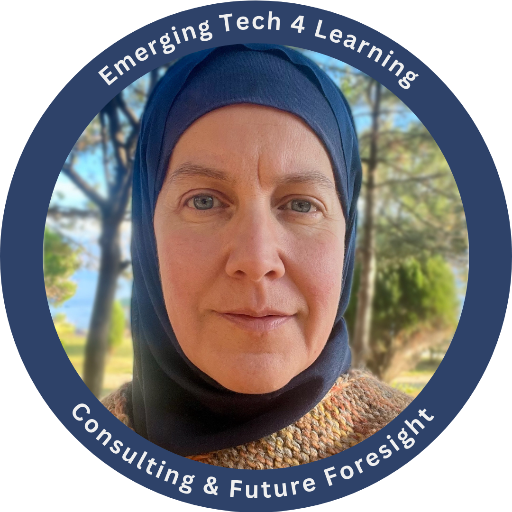One of the most fun and engaging things you can do in virtual worlds is to build something. This is why there are millions of users on social VR platforms that allow users to build and share things. These platforms give users agency, an outlet for their creativity, and pride in having created something. And it happens that building in VR can help with language learning.
Key insights
Building in VR is possible to different degrees on different platforms, and it is fun.
You can build something from scratch, use pre-build items and combine, or even use text prompts to build with an AI assistant.
Building in VR opens up a lot of engaging and fun opportunities that we can leverage for language learning with collaborative tasks, project-work and more.
What does building in VR mean?
First off, this is not about building a VR platform, which requires coding and other professional skills VR developers have. We are interested in the possibility of building within virtual reality. I am also excluding 3D drawing in VR, which will have its own entry in this series.
Building in VR can mean creating an actual virtual environments or space on a VR platform, or any animate or inanimate 3D objects within the world (landscape, buildings, clothes, furniture, vehicles, food items, books, pets, plates… you get the idea). In some cases, you can even build, not just customise, avatars.
Tell me more
Users can build in virtual reality in three different ways:
1 Building in VR from scratch
By putting together the basic units for building available on the platform (such as cubes, spheres, cones, and other shapes), you can create any kind of object (and even avatars) in virtual worlds. Even the most complicated things in virtual worlds are built with these units.
2 Combining ready-made scenes and objects
Platform creators who provide building features want to make it easy for users with different levels of skills. So, there will often be a library of scenes and 3D objects provided by the platform creators. If the platform has a dedicated community, those with building skills will often share their creations. Some platforms have a marketplace where builders either sell or give away their creations.
3 AI-assisted VR building
This technology is now becoming available to platform users in varying forms and capabilities. With these tools, building doesn’t happen ‘manually’ but through… you guessed it… text prompts. It can, of course, be combined with the other forms of building.
Beware of causing performance issues
Keep in mind when building in VR is that the more objects there are in a scene at one time, the more it can slow down performance of the virtual world. So if you’ve been filling your virtual world with lots of objects, and you notice any issues with performance, clear the space!
How does building help with language learning in VR?
Motivation is one of the most important drivers, if not the most important. Building in VR can increase motivation because it is fun and learners can be creative. In addition to that, learners have agency and tasks can be personalised. Learners are also active while learning, all which can increase motivation.
Building also helps engage learners in social learning when they have to collaborate to complete tasks. And we know that learning together with others helps learning. In fact, some say that all learning is social.
When building, learners are focused on the task rather than too much on the language, which can reduce anxiety. Anxiety in language learners is an issue, so anything that can reduce it is good.
Building in VR is also a realistic task, or authentic activity, because it is actually something that users do in virtual worlds. This kind of authenticity is important for learning to be meaningful.
And finally, learners understand, learn and remember words better and longer when they visually, physically and spatially engage with the environment and objects.
Example
Imagine a lesson with a language focus on reviewing prepositions of place and giving directions, names of shapes and colours. Students follow instructions to learn to build simple objects from scratch, using the basic building blocks on the platform (cubes, spheres, pyramids, etc). As homework, they meet up and teach each other building skills. In follow-up lesson, the students create an exhibition with their creations. Each student shows their creation and explains what it is, what it is used for, why and how they built it, or similar.
Put your knowledge into action!
Language educator
How can you give your learners more agency in your VR lessons or their homework?
How would you make use of building features in a virtual world? Think of a lesson plan.
Language learner
Can you build in your favourite virtual world? Try building something with your friends, or teach each other how to build something. Learn the names of the building tools and blocks in the language you are learning.
Edtech company
Having read about the benefits of building for language learning and the kind of activities learners and teachers can do in VR language lessons, how can you support this?
This blog post has developed into nearly 2200 words on 6 pages and is one of the entries in our new book The A–Z of Immersive Language Learning and Teaching in Virtual Reality.

Explore how, why, and when virtual reality and other emerging technologies such as generative AI can support and enhance language learning with The A-Z of Immersive Language Learning and Teaching in Virtual Reality.
This book is essential reading for language educators, curriculum writers, learning experience designers, and EdTech companies seeking to integrate technology with pedagogy and content for best learning outcomes. It will help you gain the knowledge you need to think, plan, and implement immersive learning experiences effectively with VR. By Nergiz Kern and Miranda Novash (2025). More information.
